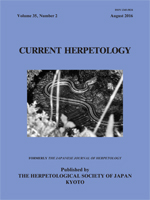By forced vomiting of stomach contents, we examined the diet of Lithobates catesbeianus inhabiting the city region of Kyoto, central Japan. Among various animal taxa consumed, crustaceans, including Asellota and Oniscoidea in juveniles and introduced American crayfish Procambarus clarkii and native crab Potamon dehaani in adults, occupied the largest proportion in number. In volume, the crayfish and crab also comprised the larger part, and the rest was composed mainly of beetles, bugs, and centipedes. Food habits of L. catesbeianus from Kyoto are characterized by the following points: (1) the frog tends to take a smaller number of larger prey as its body size increases; (2) aquatic prey animals, especially crustaceans, seem to be more important than terrestrial ones; (3) feeding intensity seems to be constant throughout the active seasons, including the breeding season; and (4) vertebrates comprise only very small proportion of the diet, despite their apparent availability, strongly contrasting to previous studies in other localities. Effects of predation on native animals seem to be not very large at present.
How to translate text using browser tools
1 August 2016
Food Habits of the American Bullfrog Lithobates catesbeianus in the City of Kyoto, Central Japan
Krassimir Dontchev,
Masafumi Matsui
ACCESS THE FULL ARTICLE

Current Herpetology
Vol. 35 • No. 2
August 2016
Vol. 35 • No. 2
August 2016
American bullfrog
central Japan
City region
food habits
prey habitat




